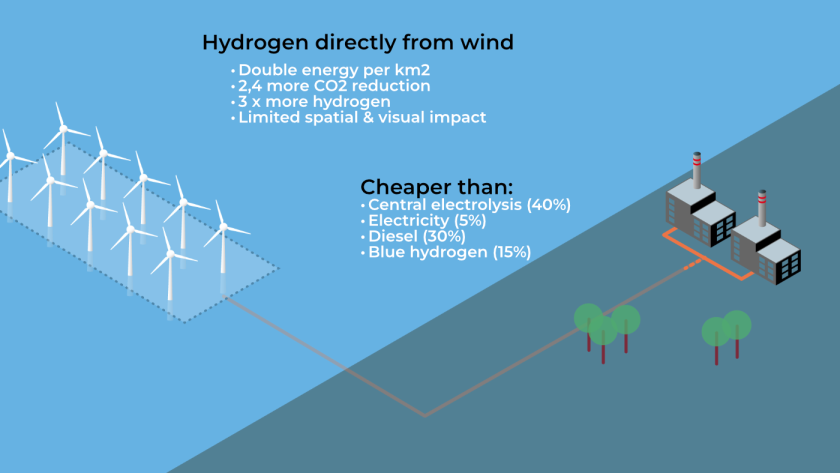Current wind turbine designs prioritise economic optimisation to generate electricity at the highest prices while minimising costs. However, this approach does not utilise all the available wind energy or reach the technical limits of wind energy yield. With our advanced technology and expertise, we are ready to help you improve the efficiency of your wind turbine or wind farm. We are also actively seeking partnerships for wind farm development. Do not hesitate to contact us if you are interested in exploring these opportunities further.
By producing hydrogen directly from wind turbines, we can capture a much larger amount of wind energy. This allows a higher energy yield per turbine, creating a whole new economic optimum for wind energy. By integrating electrolysis into wind turbines and connecting them to hydrogen pipelines, we can generate more wind energy per unit of available space, per turbine, and deliver it to end users at a lower cost.

Larger turbines capture more wind energy at higher altitudes, but designing turbines specifically for high winds increases the cost per kWh when using electrical infrastructure. To keep costs low, smaller generators are used, resulting in reduced power generation in high wind conditions.
By producing hydrogen directly from wind turbines, we can capture a much larger amount of wind energy. Using pipelines to distribute the hydrogen energy can reduce the cost of the required infrastructure 20 times.
As the size of wind turbines increases, the market price of electricity falls during periods of strong wind. The cost of electrical components also increases, resulting in a sub-optimal balance between turbine size and power generation. This limitation results in modern turbines producing less electricity than their technical capabilities allow because they are economically optimised for using electrical infrastructure.
By producing hydrogen directly from wind turbines, we can capture a much larger amount of wind energy. Using pipelines to distribute the hydrogen energy can reduce the cost of the required infrastructure 20 times.
Transporting energy in the form of gas is less expensive than electricity. Gas grid connections are around 20 times cheaper than equivalent electricity grid connections. In addition, gas pipelines can act as storage systems by regulating pressure, thus mitigating the effects of energy imbalances or oversupply caused by strong winds. Hydrogen pipelines offer new economic optimisation opportunities for wind energy.
By integrating electrolysis directly into wind turbines, we eliminate multiple conversion steps and the need for costly electrical components. The use of more affordable pipeline connections is revolutionising the economics of wind energy.
Optimising the distance between turbines and using pipeline infrastructure instead of traditional cables significantly increases energy yield and reduces the cost per megawatt hour (MWh). By using available technologies and optimising generator capacity, we can generate 60% more energy at a lower cost per MWh than with electricity alone.
While large-scale grid-connected electrolysis plants and innovation will contribute to cost reductions in the hydrogen sector, generating more and cheaper wind energy with hydrogen turbines is already achievable with current technology. System integration and scaling up the production of electrolysis stacks are key. A clear legal framework and increased demand for hydrogen will naturally drive costs down, potentially surpassing the cost levels of wind power production with electricity.
Hydrogen turbines, with larger generators relative to blade length, and hydrogen wind farms, optimised for turbine spacing, provide higher energy output in strong winds while ensuring cost-effective delivery to end users. Hydrogen's low transport costs and inherent storage capabilities make it an ideal energy carrier.
Interested in exploring the opportunities? Give us a call or fill in our contact form and we will be happy to discuss how we can meet your specific requirements.
Or read our long read: Double the energy from wind, with hydrogen as primary energy carrier

